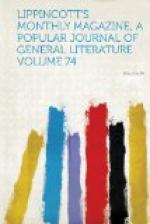The eight arched windows of the corner towers, twelve and a half by thirty-four feet, are utilized for art-display. Munich fills two with stained glass: England also claims a place in them. The iron doors of the front are inlaid with bronze panels bearing the insignia of the States; the artist prudently limiting himself to that modest range of subjects in recognition of the impossibility of eclipsing Ghiberti at six months’ notice. Thirty years is not too much time to devote to completing the ornamentation of this building. Five, seven or ten millions of people will pass through it in the course of its first year, and among them will be some capable of making sound suggestions for its finish. The wisdom that comes from a multitude of counsels will remain to be sifted. Then will remain the creation of the artists who are to carry the counsels into execution. We shall be fortunate if the next three decades bring us men thoroughly equal to the task.
[Illustration: Memorial hall, with extension.]
It would be an unpardonable neglect of the maxim which enjoins gratitude to the bridge that carries us safely over were we to complete our tour of the exposition structures without a glance at the graceful erections, diverse in magnitude and design, which overleap the depressions so attractive to the student of the picturesque and so trying to the pedestrian. The aesthetic capabilities of bridge architecture are very great, and a fine field is here offered for their display. The flat expanses of Hyde Park, the Champs de Mars and the Prater could afford no such exhibition. The ground and the buildings became, perforce, two sharply distinct things; and the blending into unity of landscape and architecture could be but imperfectly attained. Here the case is very different. With the aid of an art that embraces in its province alike the fairy trellis and the monumental arch and pilaster, the lines of Memorial Hall and other permanent edifices may be led over the three hundred acres appropriated to the exposition. From the foundation of a bridge-pier to the crowning statue of America, the artist finds an uninterrupted range.
The work of his foster-brother, the artisan, has certainly been well done. The structures we have been traversing are, in their way, works of art—very worthy, if not the choicest conceivable, blossoms of our century-plant. For fitness, the quality that underlies beauty throughout Nature from the plume to the tendril and the petal, they have not been surpassed in their kind. Every flange, bolt, sheet and abutment has been well thought out. Whatever the purpose, to bind or to brace, to lift or to support, everything tells.
SKETCHES OF INDIA.
IV.—CONCLUSION.




